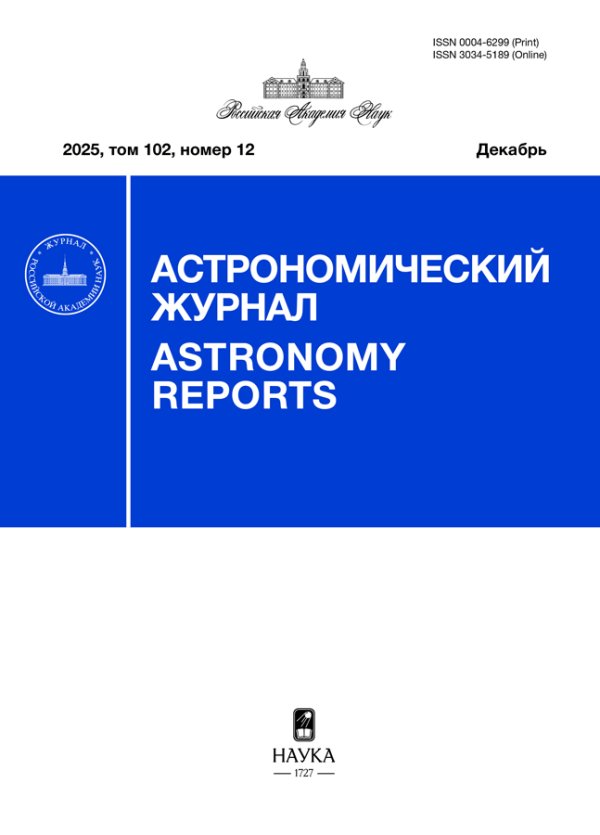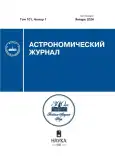Vol 101, No 1 (2024)
Articles
Image of a black hole illuminated by a parabolic screen
Abstract
A model of an illuminating black hole surface (“parabolic screen”) is proposed. This allows to avoid in a natural way the appearance of edge effects related with photons moving along the screen plane. The temperature distribution along the radius corresponds to the corresponding distribution for a relativistic disk (Novikov-Thorne disk). It is shown that the structure of the formed black hole shadow essentially differs from the case when the source of photons is a distant screen, since in the considered model the photons, subjected to strong gravitational lensing of the black hole, are emitted by the “backward” side of screen, which would not be visible in the absence of the black hole. In the thin screen approximation, shadow images are constructed for the Schwarzschild black hole in the cases when the angle between the symmetry axis of the illuminating screen and the direction to the observer is equal to 5, 30, 30 and 80 angular degrees, similar images for the Kerr black hole are constructed for the cases of 60 and 80 angular degrees.
 2-11
2-11


Orbital Period Variations of the Eclipsing Binaries RW Cap, BG Peg, and CU Peg
Abstract
The variations in the orbital period of the eclipsing binaries RW Cap, BG Peg, and CU Peg have been analyzed. The variations in the period of RW Cap and BG Peg can be well represented by cyclic variations with large amplitude. It has been shown, that these variations cannot be explained by the presence of a third body. They can be a consequence of the magnetic activity of the secondary components having a convective zone. The variations in the period of CU Peg can be represented by a superposition of a secular period increase due to exchange of matter between the components and cyclic variations. These cyclic variations can occur due to the presence of a third body in the system or they can be a consequence of the magnetic activity of the secondary component.
 12-24
12-24


Modeling of the exoplanet HAT-P-11b magnetosphere
Abstract
Based on the available data on the magnetic field of the star HAT-P-11 and its closest exoplanet HAT-P-11b, as well as information on the stellar wind in this system, we construct the HAT-P-11b magnetic field magnetospheric model. We show how the value and orientation of the interplanetary magnetic field control the magnetospheric structure. Each component of the stellar wind’s magnetic field creates a specific type of reconnection with the exoplanet’s magnetic field.
 25-33
25-33


MHD modeling of the molecular filament evolution
Abstract
We perform numerical magnetohydrodynamic (MHD) simulations of the gravitational collapse and fragmentation of a cylindrical molecular cloud with the help of the FLASH code. The cloud collapses rapidly along it’s radius without any signs of fragmentation in the simulations without magnetic field. The radial collapse of the cloud is stopped by the magnetic pressure gradient in the simulations with parallel magnetic field. Cores with high density form at the cloud’s edges during further evolution. The core densities are n ≈ 1.7×108 and 2×10-7 cm–3 in the cases with initial magnetic field strengths B = 1.9×10-4 and 6×10-4 G, respectively. The cores move toward the cloud’s centre with supersonic speeds |vz| = 3.6 and 5.3 km/s. The sizes of the cores along the cloud’s radius and cloud’s main axis are dr = 0.0075 pc and dz = 0.025 pc, dr = 0.03 pc and dz = 0.025 pc, respectively. The masses of the cores increase during the filament evolution and lie in range of ≈(10-20)Me. According to our results, the cores observed at the edges of molecular filaments can be a result of the filament evolution with parallel magnetic field.
 34-41
34-41


The brightness of the sky of the Caucasian Mountain Observatory of MSU in the near infrared
Abstract
The results of measurements of background brightness in the near-infrared range (bands J, H, K), carried out in 2016–2023 at the Caucasus Mountain Observatory of Moscow State University was analyzed. It is shown that the instrumental background associated with the thermal radiation of the telescope is noticeable only in the K band, and at operating temperatures its contribution mainly determines the level of the overall background in this band. The coefficients of a polynomial taking into account the contribution of instrumental and extra-atmospheric backgrounds are presented. It is shown that the brightness of the sky background does not depend on air temperature, but a weak dependence on the water vapor content is observed, close to that expected from model calculations: in the J and H bands, the background brightness decreases at a rate of ≈1%/1 mm, and in the K band it grows at a rate of ≈2.5%/1 mm. The maximum amplitude of background brightness variability on short time scales (~30 minutes) has been estimated: ≈10% in the J and K bands and ≈30% in the H band. The maximum contribution of Moon’s radiation scattered in the atmosphere to the overall background level has been determined. It is shown that this contribution can be ignored at an angular distance of the observation point from the Moon greater than ~10° even during a full moon. The average background surface brightness mag/arcsec² in the J, H and K bands was calculated: mJ = 15.7, mH = 13.9 and mK = 13.1.
 42-55
42-55


Gnevishev-Ohl rule: current status
Abstract
A statistical study of the statements of the Gnevyshev—Ohl rule (GOR) and of some its interpretations has been carried out. The original formulation of the GOR states that for the summary index of solar activity over the 11-year cycle SW, there is a close connection in pairs of an even and the subsequent odd cycles (EO), while opposite pairs (OE) exhibit no such connection. This statement strictly holds with the significance level a = 0.01, for the new version of the sunspot index SN 2.0 (Wolf numbers). In this case, an even cycle is followed by an odd one with a greater SW. For amplitudes of cycles the GOR is observed only as a trend, and the difference of connections in pairs of cycles EO and OE is statistically insignificant. The alternation of the cycle magnitude, both for the parameter and the amplitudes, is also not statistically confirmed. It has been found that various aspects of the GOR are statistically better fulfilled for the new version of the sunspot index SN 2.0, which speaks in favor of further use of this index in solar physics.
 56-64
56-64












